Best Home Telescope For Viewing Planets (2024 Update)
Looking up at the night sky and gazing at the stars is one of life’s simple pleasures. For many, it awakens a sense of wonder about the vastness of the universe. If you want to take your stargazing to the next level, a home telescope for viewing planets is a great investment. But with so many options on the market, how do you choose the right one?
When shopping for the best home telescope for planets, there are a few key factors to consider. First, think about the type of telescope – refractors, reflectors, and compound models all have their pros and cons. Next, look at the aperture, or diameter of the primary mirror/lens. Generally, a larger aperture means better light-gathering ability and clearer views. The mount and tripod are also important for stability when pointing at celestial objects.
You’ll also want to consider extras like magnification eyepieces, finder scopes, computerized tracking, and software. Useful features can include GPS, WiFi, and phone connectivity. And don’t forget portability if you want to take your telescope on trips away from light pollution. Finding the right balance of performance, ease of use, and features at your budget point is the goal.
Do you want to explore Mars up close? Resolve the rings of Saturn? Or spot the swirling clouds on Jupiter? Would you like to catch glimpses of nebulas, galaxies, star clusters and more? With a quality home telescope, you can tour our solar system and deep space wonders right from your own backyard. Why not make today the day you take your passion for astronomy to the next level?
10 Best Home Telescope For Viewing Planets
| # | Product Image | Product Name | Product Notes | Check Price |
|---|---|---|---|---|
|
1
|
The product is ideal for efficient and precise mowing of large lawns or commercial spaces.
|
|
||
|
2
|
The product is ideal for astronomy enthusiasts who want to easily locate stars, planets and other celestial objects using their smartphone.
|
|
||
|
3
|
It is ideal for amateur stargazers who want to use their smartphone to locate and learn about celestial objects.
|
|
||
|
4
|
The product is ideal for observing stars and planets in the night sky, providing a professional-level experience with German technology.
|
|
||
|
5
|
The product is ideal for viewing celestial objects such as stars, planets, and nebulas using computerized technology.
|
|
||
|
6
|
This product is ideal for adults who are interested in astronomy and want to view celestial objects using a telescope.
|
|
||
|
7
|
The product is ideal for stargazing and observing celestial objects with its advanced optics and computerized tracking system.
|
|
||
|
8
|
This product is ideal for adults, kids, and beginners who are interested in astronomy and stargazing.
|
|
||
|
9
|
The product is ideal for individuals looking for a compact and portable computerized telescope with advanced optical design and alignment technology.
|
|
||
|
10
|
The product is ideal for viewing celestial objects using a reflector telescope with an equatorial mount.
|
|
1. Gskyer
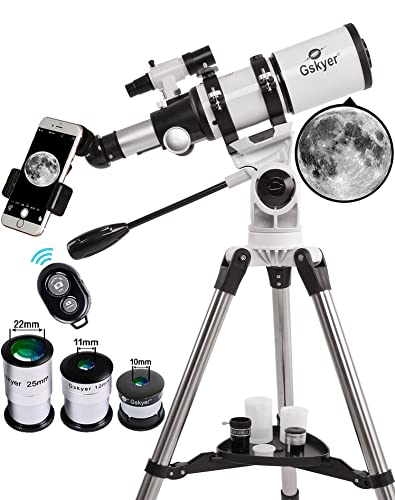
Introducing the Ultra-Clear Refracting Telescope, the perfect tool for stargazing enthusiasts and curious learners alike. This telescope boasts a 400 mm focal length and 80 mm aperture, which means it can capture more light and produce brighter, clearer images for optimal viewing pleasure. Its optical glass coating also enhances image brightness, all while protecting your eyes.
The Ultra-Clear Refracting Telescope comes with three replaceable eyepieces (16X, 40X, 80X) and a 3X Barlow lens, giving you a range of magnification options for a variety of celestial objects. It also features a 6*30 finder scope with mounting bracket and erect-image diagonal, making it easier to locate objects in the night sky.
Equipped with an adjustable tripod, this telescope allows for many different viewing positions and a stable platform. It's quick and easy to set up, even for novice users, and is a great way to encourage kids to learn about space. It makes for an excellent gift idea for any young science or astronomy enthusiast.
At Ultra-Clear, customer satisfaction is a top priority. That's why they offer reliable and friendly customer service within a 24-hour time frame. Additionally, the Ultra-Clear Refracting Telescope comes with a 1-year care plan for free replacement, giving you peace of mind with your purchase.
2. Starsense Explorer: Your Personal Stargazing Companion.
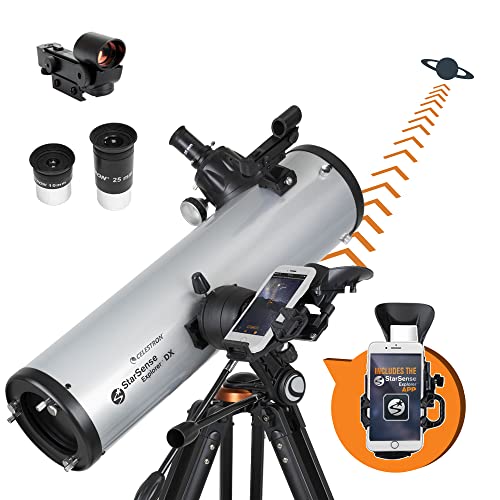
Discover the wonders of the night sky with the Celestron StarSense Explorer Telescope. Whether you're new to stargazing or an experienced astronomer, this telescope allows you to easily explore the galaxy using your smartphone.
Featuring patented StarSense sky recognition technology, this telescope analyzes star patterns and calculates its position in real-time using your smartphone. The StarSense Explorer app generates a list of the best objects to view based on your location and time, making it easy to locate stars, planets, and other celestial objects.
Setting up the telescope is a breeze thanks to its manual altazimuth mount with smooth, dual-axis slow-motion controls. Simply follow the arrows on your smartphone screen to locate your desired target, and when the bullseye turns green, it's ready to view in the telescope's eyepiece.
The high-quality 130mm Newtonian reflector boasts a 5" primary mirror with highly reflective coatings, providing ample light gathering ability to view craters on the Moon, Jupiter, Saturn, Mars, and deep sky objects like the Orion Nebula, Andromeda Galaxy, and Pleiades Open Star Cluster.
Buy with confidence from Celestron, a leading telescope brand in California since 1960. Your purchase includes a 2-Year US Warranty and unlimited support from our team of US-based experts.
Experience the universe like never before with the Celestron StarSense Explorer Telescope.
3. Celestron – Starsense Explorer Lt 80az Smartphone App-Enabled
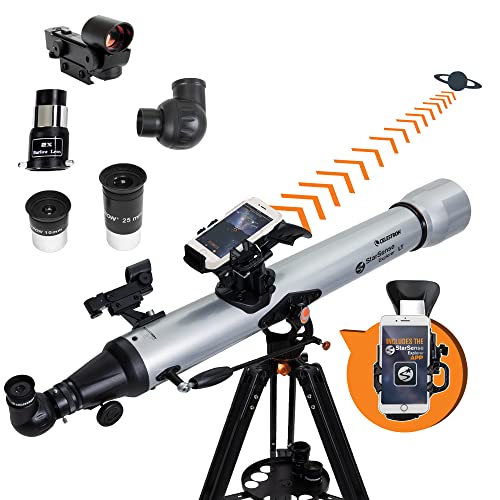
The telescope equipped with patented StarSense sky recognition technology is a unique and innovative device that guarantees a fascinating stargazing experience. With this technology, the telescope uses your smartphone to analyze star patterns overhead and calculate its position in real-time. This feature is a game-changer, as it eliminates the need for manual calibration and makes stargazing easier than ever before.
The StarSense Explorer app is another remarkable feature of this telescope. By generating a list of the best objects to view based on your exact time and location, the app ensures that you get the most out of your stargazing experience. The app enables you to view not only planets, brighter nebulae, galaxies, and star clusters from the city but also fainter, deep sky objects from darker sites.
Setting up and using the telescope is a breeze, thanks to its manual altazimuth mount with a slow motion rod. The on-screen arrows guide you to your desired target, and when the bullseye turns green, it's ready to view in the telescope's eyepiece. This feature makes the telescope user-friendly and suitable for beginners and experts alike.
The telescope has an 80mm refractor that boasts fully coated glass optics. These optics provide bright, sharp, and clear views of craters on the Moon, Jupiter, Saturn, Mars, and deep sky objects like the Orion Nebula. The high-quality optics ensure that you get the best possible view of the night sky.
When you buy the telescope from Celestron, a leading telescope brand in California since 1960, you get a 2-Year US Warranty and unlimited support from their team of US-based experts. This unbeatable warranty and support give you peace of mind and confidence in your purchase.
4. Gskyer Eq-130 Telescope: Brilliant German Design.
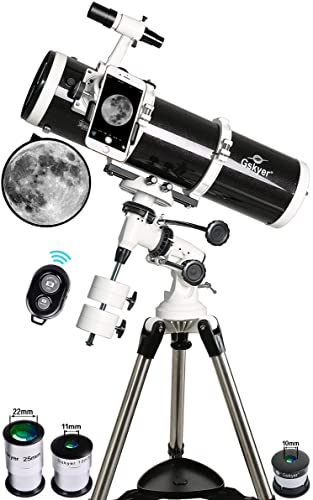
This reflector telescope is an excellent choice for individuals who are enthusiastic about exploring the night sky. With its 5.1 inch aperture and all-glass optical components that have high transmission coatings, this telescope provides enhanced image brightness and clarity, making it ideal for observing celestial objects such as the Moon, planets, galaxies, nebulas, and star clusters.
The telescope's short 24-inch optical tube design, fast f/5 focal ratio, and toothless focusing base make it user-friendly for both beginners and advanced astronomers. The toothless focusing base provides a smooth and accurate focusing experience, ensuring that you can focus on the celestial object you want to observe with ease.
This telescope comes with complete parts, including three eyepieces, a 3X Barlow lens, a finderscope, and an adjustable tripod, making it easy to find and observe celestial objects from any viewing position. The tripod is adjustable, allowing you to set it up at the perfect height for your observation needs.
The telescope comes with a wireless remote control that can be paired with your device via Bluetooth, compatible with both iPhone or Android devices. With the Bluetooth camera remote, you can take pictures or videos of the celestial objects you observe and share them with your family and friends in real-time.
The manufacturer provides excellent customer support service, and with a 1-year warranty and lifetime maintenance, you can be confident in the quality and reliability of this telescope. If you have any questions or concerns about the product or service, the manufacturer is always available to help ensure your satisfaction.
5. Nexstar 130slt Computerized Telescope: Compact Sky Wizard
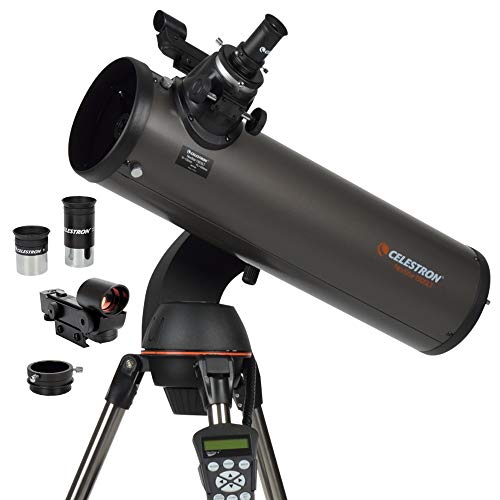
Introducing the Celestron NexStar 130SLT, a computerized telescope that offers an extensive database of more than 40,000 stars, galaxies, nebulae, and other celestial objects. It's the perfect tool for beginners and seasoned stargazers alike who want to explore the wonders of the night sky.
Equipped with a Newtonian reflector optical design and a large 130mm aperture, the NexStar 130SLT can gather enough light to provide breathtaking views of our Solar System and beyond. With it, you can observe Saturn's rings, Jupiter's cloud bands, the Moon's craters, and even the Orion Nebula in stunning detail.
One of the best features of the NexStar 130SLT is its compact and portable design. It's perfect for adults and kids to use together, and it's easy to transport to your favorite observing site, whether it's a campsite, a dark sky location, or simply your backyard.
Setting up the NexStar 130SLT is a breeze thanks to Celestron's proprietary SkyAlign procedure. Simply center any three bright objects in the eyepiece, and the telescope automatically aligns itself with the night sky, ready to locate thousands of objects.
When you purchase the Celestron NexStar 130SLT from an Authorized Dealer on Amazon, you can buy with confidence knowing that you'll receive a 2-Year US Warranty and unlimited support from a team of US-based experts. Celestron is a leading telescope brand in California since 1960, and they stand behind their products.
As a bonus, your Celestron NexStar 130SLT comes with a free download of Starry Night Special Edition, one of the top-rated astronomy software programs. With this software, you can simulate the sky, learn about celestial objects, and plan your observing sessions with ease.
6. Astropro Reflector Telescope With Smartphone Adapter.
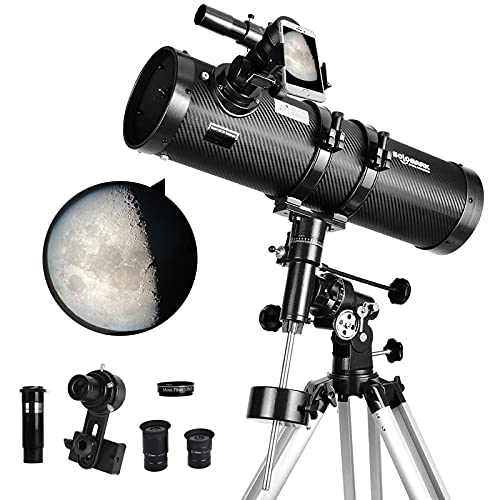
This telescope boasts a large aperture of 130mm, which makes it perfect for observing deep space celestial objects. Its high-resolution imaging and excellent light-collecting ability allow for brighter and more detailed observations.
The telescope's sturdy and lightweight frame structure is covered in carbon fiber, which is a sophisticated technology that ensures durability. Additionally, the objective lens features fully-coated glass optics that improve the optical system performance of astronomical telescopes.
The German Equatorial Mount of this telescope comes with dial and fine-turned control cables, allowing for precise positioning and fast tracking of celestial bodies. This makes the observation process more stable and enjoyable.
The tripod that comes with this telescope is a high-quality large diameter adjustable aluminum alloy tripod with a tray attached for storing small temporary attachments. The stable structure of the tripod enables the user to locate celestial objects smoothly and accurately.
This telescope also comes with multiple accessories, including 2 high-quality eyepieces, a 1.5X erecting Barlow lens, a 1.25" 13% transmission moon filter, and a cellphone adapter. These accessories ensure that the user has everything they need to observe celestial objects.
If there are any questions or concerns about the telescope or its accessories, the customer service team is available to help 24/7. This telescope is a great choice for anyone looking to observe deep space celestial objects with ease and precision.
7. Celestron – Nexstar 8se
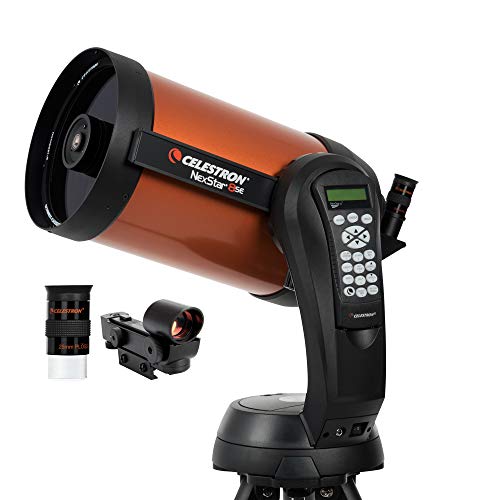
The NexStar 8SE Computerized Telescope is an excellent choice for both novice and seasoned stargazers. It sports Celestron's signature orange tube design, but with advanced technology and features that make it stand out from other telescopes in the market.
This telescope boasts an 8-inch primary mirror, which provides ample light-gathering capability for observing celestial objects in our Solar System. Despite its powerful optics, the telescope maintains a compact form factor, making it highly portable and easy to handle. Moreover, it is compatible with starsense technology and Wi-Fi, which enables you to control it remotely and wirelessly.
What sets this telescope apart from others is its fully-automated go-to mount. The mount comes with a database of over 40,000 celestial objects, allowing it to automatically locate and track objects for you, saving you time and effort. With SkyAlign technology, the telescope is aligned and ready for use in just a few minutes.
The NexStar 8SE is also incredibly easy to assemble and break down, thanks to its single fork arm design and sturdy steel tripod. The components come apart quickly, making it easy to transport and store.
Finally, the NexStar 8SE comes with unbeatable warranty and customer support. The telescope brand has been operating in California since 1960 and offers a 2-year warranty and unlimited access to technical support from a team of US-based experts. This means you can buy with confidence, knowing that you are getting a high-quality telescope that is backed by excellent customer support.
8. Astropro Telescope Kit For Kids And Adults
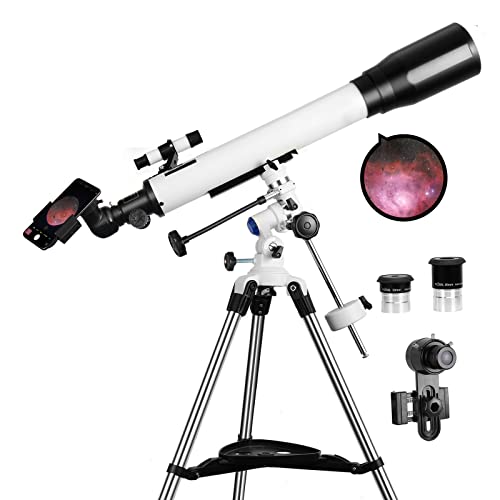
Introducing a versatile Telescope suitable for both Kids and Adults, designed to provide erect image optics for both terrestrial and astronomical use. Its fully multi-coated optics glass lens with high transmission coatings creates stunning images and ensures your eyes are well protected.
The Telescope boasts of an impressive 70mm Aperture and 700mm Focal Length, providing superior optical quality. It comes with 10mm and 20mm Plossl eyepieces, which have better optical performance than K and H eyepieces, effectively reducing chromatic aberration and halo. With a magnification of 70X and 35X, you can enjoy crystal clear images of the celestial bodies or breathtaking sceneries on earth.
The Equatorial Mount Type is designed with two slow motion control cables that allow for easy and precise pointing adjustments to the telescope in both R.A. and Declination. This ensures you get a seamless viewing experience with minimal disruptions.
Setting up the Telescope is a breeze with the quick and easy no-tool setup feature. The makers of this Telescope provide a professional astronomical Telescope that can be installed without any additional tools, allowing you to spend more time observing the stars.
The Telescope comes with a full-size stainless steel adjustable tripod that meets any height and angle requirements, ensuring stability, safety, and durability. Additionally, it includes a smartphone adapter with 1.5X Barlow Lens which provides 70x magnification, allowing you to capture and share images and videos of your observations with friends and family.
9. Celestron Portable Computerized Telescope With Skyalign Technology
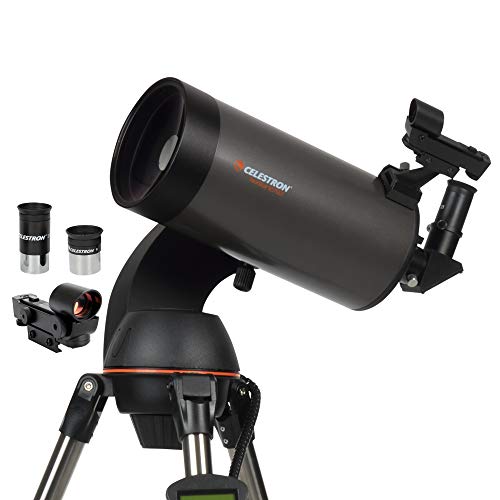
The Celestron NexStar 127SLT is a computerized telescope that boasts a database of over 40,000 celestial objects, including stars, galaxies, and nebulae. With just a few clicks, users can select an object of interest, and the telescope will automatically locate and track it as it moves across the night sky.
Featuring a MAKSUTOV-CASSEGRAIN optical design, the NexStar 127SLT is equipped with a 127mm aperture that can capture enough light to provide stunning views of the Solar System and beyond. By peering through the eyepiece, users can observe Saturn's rings, Jupiter's cloud bands, the Moon's craters, and the Orion Nebula with incredible detail.
The NexStar 127SLT is also designed with portability in mind. It is lightweight and compact, making it easy to transport to your desired observation site, whether it's your backyard, a dark sky observing site, or your favorite campsite. Setup is quick and easy with Celestron's proprietary SkyAlign procedure, which allows users to align the telescope to the night sky in just a matter of minutes.
Celestron is a trusted brand in the telescope industry, and the NexStar 127SLT comes with a 2-year US warranty and unlimited support from their team of US-based experts. Additionally, with the purchase of the NexStar 127SLT, users will receive a free download of Starry Night Special Edition, one of the top-rated astronomy software programs. This software allows users to simulate the night sky, learn about celestial objects, and plan their observing sessions with ease.
10. Orion 09007 Spaceprobe 130st Equatorial Reflector Telescope (Black)
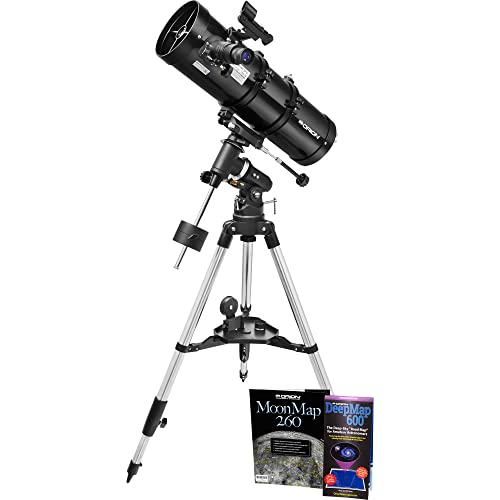
The SpaceProbe 130ST EQ is a versatile reflector telescope with a 5.1" aperture that gathers an ample amount of light to provide great views of the planets, Moon, galaxies, nebulas, and star clusters. Its compact optical tube design makes it easy to transport to different locations, and its fast f/5 focal ratio ensures pleasing wide-field performance.
This sturdy telescope is mounted on an equatorial mount with an adjustable tripod that allows manual slow-motion tracking of celestial objects as they appear to migrate across the night sky. The complete assembled telescope weighs only 28 lbs., making it convenient to transport to your desired viewing location.
The SpaceProbe 130ST EQ comes with two 1.25" Plossl eyepieces – 25mm and 10mm – that provide great magnification and clarity. Additionally, it includes a smartphone camera adapter, DeepMap 600, MoonMap 260, collimation cap, and more!
Whether you're a beginner or an experienced astronomer, the SpaceProbe 130ST EQ is a great choice for observing the night sky. Its sturdy mount and versatile design make it a telescope the whole family can enjoy. With its impressive specs, you can rest assured that your viewing experience will be enjoyable and rewarding.
Best Home Telescope For Viewing Planets FAQs
Can I see all planets with a home telescope?
The answer to this question depends on a few factors. First, the size and quality of your home telescope will play a big role in what you can see. Second, the distance and position of the planets in relation to Earth will also impact your ability to see them.
With a high-quality telescope and the right conditions, you should be able to see several planets in our solar system from home. These include Jupiter, Saturn, Mars, Venus, and sometimes even Uranus and Neptune. However, it's important to note that some planets may be more difficult to see than others, and you may need to wait for specific times of the year or certain weather conditions to get a good view.
Additionally, it's important to have realistic expectations about what you'll be able to see. Even with a powerful telescope, planets will still appear as small dots of light, rather than the detailed images you may have seen in photographs. However, observing these distant objects can still be a fascinating and rewarding experience for amateur astronomers.
Can I view planets from a light-polluted area with a home telescope?
Viewing planets with a home telescope from a light-polluted area can be challenging, but it is possible. Light pollution can make it difficult to see faint objects in the night sky, but planets are relatively bright and can still be observed with a telescope. However, the quality of the view may be affected by the amount of light pollution in the area.
To improve your chances of viewing planets from a light-polluted area, you can use a telescope with a larger aperture, which will allow more light to enter and provide a brighter, clearer image. You can also use filters to reduce the amount of light pollution that enters the telescope and affects the image.
It is important to note that even with a high-quality telescope and filters, the image may not be as clear as it would be in a dark sky location. However, with patience and perseverance, you can still enjoy viewing planets from a light-polluted area.
How important is aperture for planet viewing?
Aperture plays a crucial role in planet viewing. A telescope's aperture determines how much light it can gather and how well it can resolve fine details. The larger the aperture, the more light the telescope can gather, resulting in brighter and sharper images. It is important to note that planets are relatively small and bright objects, and they require high magnification to see fine details, which means that a larger aperture is necessary to achieve the desired image quality.
Additionally, the atmosphere plays a significant role in planet viewing, causing the images to appear distorted and blurry. A larger aperture telescope can help reduce the effects of atmospheric distortion by gathering more light and producing a brighter image.
In conclusion, the aperture is a critical factor when it comes to planet viewing. A larger aperture telescope can provide brighter and clearer images, making it easier to observe fine details and reducing the effects of atmospheric distortion.
How much magnification do I need to view planets?
To view planets, you will need a telescope with a certain level of magnification. The amount of magnification you need will depend on the size and distance of the planet you want to observe.
As a general rule, a magnification of at least 30x per inch of telescope aperture is required to view planets. So, for example, if you have a 6-inch telescope, you would need a magnification of at least 180x to view planets. However, it's important to note that magnification alone is not enough to get a clear view of planets. Atmospheric conditions, the quality of your telescope and eyepiece, and the time of day all play a role in the quality of your observations.
In addition to magnification, you will also need to consider the type of telescope you are using. Refracting telescopes are better suited for viewing planets due to their ability to provide high contrast and sharp images. Reflecting telescopes are better suited for deep-sky objects like galaxies and nebulae.
Overall, the magnification you need to view planets will depend on several factors, but a good rule of thumb is 30x per inch of telescope aperture.
What accessories do I need to view planets with a home telescope?
To view planets with a home telescope, you will need a few accessories to enhance your viewing experience. Firstly, you will need an eyepiece. A good quality eyepiece will help you see the planets in greater detail by magnifying the image. For planets, an eyepiece with a focal length of around 10-15mm is ideal.
Next, you will need a Barlow lens. This is an accessory that increases the magnification of your eyepiece, allowing you to see more details on the planet's surface. A 2x Barlow lens is a good starting point.
A finderscope is also essential for locating the planets in the night sky. It is a small telescope mounted on top of your main telescope, which helps you aim at the desired planet.
Finally, a moon filter can be used to reduce the brightness of the moon, making it easier to observe details on its surface.
Overall, investing in good quality accessories can greatly enhance your experience of viewing planets with a home telescope.
What is the best home telescope for viewing planets?
When it comes to choosing the best home telescope for viewing planets, there are a few factors to consider. The most important factor is the telescope's aperture or the diameter of its lens or mirror. A larger aperture allows for better light gathering and thus, clearer images of planets. A good rule of thumb is to choose a telescope with an aperture of at least 3 inches.
Another factor to consider is the telescope's magnification. While high magnification can make planets appear larger, it can also make the image blurry. A telescope with a moderate magnification of around 100x to 150x is ideal.
Based on these factors, one of the best home telescopes for viewing planets is the Celestron NexStar 6SE. It has a 6-inch aperture, which allows for clear and bright images of planets and other celestial objects. It also has a magnification of up to 300x, which is suitable for planetary observation. Additionally, it comes with a computerized mount, making it easy to locate and track planets in the night sky.
What is the best time of year to view planets with a home telescope?
The best time of year to view planets with a home telescope largely depends on the planet's position in relation to Earth's orbit around the sun. Generally, the best time to see planets like Jupiter and Saturn is during their opposition, which occurs when they are on the opposite side of the Earth from the sun. This usually happens once a year for each planet. For example, Jupiter's opposition typically occurs in July, while Saturn's opposition is usually in August.
Mars can be best viewed during its opposition as well, which occurs about once every two years. Venus and Mercury, on the other hand, can be best viewed during their greatest elongation, which is when they are farthest from the sun and appear brightest in the sky.
It's important to note that weather conditions and light pollution can also affect the visibility of planets. Therefore, it's always a good idea to check for clear skies and minimal light pollution before setting up your telescope.
What is the best type of telescope for planet viewing?
When it comes to viewing planets, the best type of telescope would be a refracting telescope with a large aperture. Refracting telescopes use lenses to focus light and produce clear, high-contrast images. The larger the aperture of the telescope, the more light it can gather, resulting in brighter and more detailed views of planets.
In terms of specific models, the Celestron NexStar 6SE and the Meade Instruments ETX125 Observer are both highly recommended for planetary viewing. These telescopes have large apertures, high-quality optics, and advanced tracking systems that allow for precise positioning of the telescope.
It's also important to consider the magnification and eyepieces used with the telescope. Planetary viewing typically requires higher magnifications, so investing in additional eyepieces with shorter focal lengths can enhance the viewing experience.
Overall, a high-quality refracting telescope with a large aperture and advanced tracking system, such as the Celestron NexStar 6SE or Meade Instruments ETX125 Observer, would be the best choice for observing planets.
What is the price range for a good home telescope for planet viewing?
The price range for a good home telescope for planet viewing can vary depending on the features and specifications. Generally, a decent beginner telescope for planetary viewing can cost anywhere from $200 to $500. However, more advanced telescopes with advanced features such as computerized tracking systems, larger aperture, and better optics can cost upwards of $1000 or more. It is important to keep in mind that while a higher price tag may offer better performance, it may not always be necessary for beginners or casual observers. It is recommended to do research on different telescopes within the desired price range and consider factors such as ease of use, portability, and maintenance before making a purchase. Additionally, it is important to have realistic expectations and understand that atmospheric conditions and light pollution can affect the quality of the viewing experience.
What should I look for when choosing a telescope for planet viewing?
When choosing a telescope for planet viewing, there are a few key factors to consider. Firstly, you will want to prioritize aperture size, as this will determine how much light the telescope can gather and therefore how much detail you will be able to see. A larger aperture will allow you to see more details on planets such as Jupiter and Saturn.
Next, you will want to consider the telescope's focal length and magnification capabilities. Planetary viewing typically requires high magnification, so a telescope with a long focal length and the ability to accommodate high-magnification eyepieces is ideal.
Another important factor to consider is the telescope's stability and tracking capabilities. As planets move relatively quickly across the sky, you will want a telescope that is able to track their movement smoothly and accurately.
Lastly, consider the type of telescope you want to use. Refractor telescopes tend to be better for planetary viewing due to their high contrast and sharp images, while reflector telescopes are better suited for deep-sky objects.
Overall, prioritize aperture size, magnification capabilities, stability, tracking, and type when choosing a telescope for planetary viewing.







